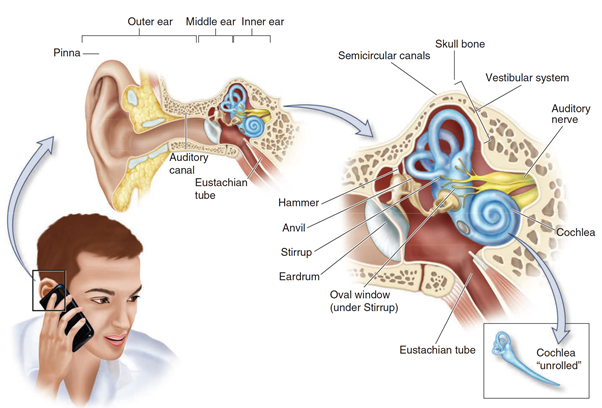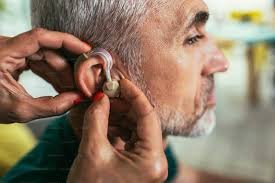The auditory system is a complex and sophisticated mechanism that enables humans and many other species to perceive sound, interpret auditory information, and navigate their environments effectively. This article delves into the intricacies of the auditory system, exploring its anatomical foundations, the perceptual processes involved in hearing, common disorders affecting auditory function, and the cultural dimensions that shape auditory perception. By examining these facets, we gain a holistic understanding of how sound is processed and how it influences human experience.
Anatomy of the Ear and Auditory Pathways
The auditory system begins with the ear, a highly specialized organ divided into three primary regions: the outer ear, middle ear, and inner ear. Each plays a distinct role in capturing, transmitting, and processing sound waves.
Hearing depends on vibrations of the air, called soundwaves. Soundwaves from the air pass through various bones until they reach the inner ear, which contains tiny hairlike cells that move back and forth (much like a field of wheat waving in the wind). These hair cells change sound vibrations into neuronal signals that travel through the auditory nerve to the brain.

The loudness of sound is determined by the amplitude or height of soundwaves. The higher the amplitude, the louder the sound. This strength, or sound-pressure energy, is measured in decibels. The sounds humans hear range upward from 0 decibels, the softest sound the human ear can detect, to about 140 decibels, which is roughly as loud as a jet plane taking off.
Outer Ear
The outer ear consists of the pinna (auricle) and the ear canal. The pinna, the visible part of the ear, funnels sound waves into the ear canal. Its unique shape aids in sound localization by modifying the frequency and direction of incoming sounds. The ear canal, a narrow tube lined with cerumen (earwax), amplifies sound waves and directs them toward the tympanic membrane (eardrum).
Middle Ear
The middle ear is an air-filled cavity housing three tiny bones—the malleus (hammer),incus(anvil), and stapes (stirrup)—collectively known as the ossicles. These bones form a mechanical linkage that transmits vibrations from the eardrum to the inner ear. The middle ear also contains the Eustachian tube, which equalizes air pressure between the middle ear and the external environment, ensuring optimal sound transmission.
Inner Ear
The inner ear comprises the cochlea, a spiral-shaped, fluid-filled structure responsible for converting mechanical vibrations into neural signals. Within the cochlea, thebasilar membraneandhair cellsact as sensory receptors. When sound vibrations travel through the cochlear fluid, they cause the basilar membrane to vibrate, stimulating the hair cells. These cells then generate electrical signals that are transmitted via theauditory nerveto the brain.
Auditory Pathways
The auditory nerve carries signals to thecochlear nucleusin the brainstem, where initial processing occurs. From there, information is relayed to higher brain regions, including thesuperior olivary complex,inferior colliculus, andmedial geniculate nucleus, before reaching theauditory cortexin the temporal lobe. These pathways enable the brain to decode sound attributes such as pitch, loudness, and location.
Pitch Perception and Sound Localization
Pitch perception and sound localization are fundamental aspects of auditory processing, allowing individuals to interpret and respond to their acoustic environment.
Pitch Perception
Pitch refers to the perceived frequency of a sound, with higher frequencies corresponding to higher pitches. The human ear can detect frequencies ranging from approximately 20 Hz to 20,000 Hz. Two primary theories explain pitch perception:
- Place Theory: Suggests that different frequencies stimulate specific regions of the basilar membrane. High-frequency sounds activate the base of the cochlea, while low-frequency sounds affect the apex.
- Temporal Theory: Proposes that the firing rate of auditory neurons matches the frequency of the sound wave, particularly for lower frequencies.
Sound Localization
The ability to determine the origin of a sound relies on binaural cues:
- Interaural Time Difference (ITD): The slight delay in sound arrival between the two ears helps localize low-frequency sounds.
- Interaural Level Difference (ILD): The difference in sound intensity between the ears aids in localizing high-frequency sounds.
- Spectral Cues: The pinna modifies sound waves based on their direction, providing additional localization information.
These mechanisms allow humans to accurately pinpoint sound sources, a skill critical for communication and survival.
Hearing Disorders
Hearing disorders can arise from genetic factors, environmental exposures, or age-related degeneration, significantly impacting quality of life.

Types of Hearing Loss
- Conductive Hearing Loss: Caused by obstructions or damage to the outer or middle ear (e.g., ear infections, otosclerosis). Sound waves are not efficiently transmitted to the inner ear.
- Sensorineural Hearing Loss: Results from damage to the inner ear or auditory nerve (e.g., noise exposure, presbycusis). This type is often irreversible.
- Mixed Hearing Loss: A combination of conductive and sensorineural hearing loss.
Common Disorders
- Tinnitus: A persistent ringing or buzzing in the ears, often linked to noise exposure or auditory nerve damage.
- Meniere’s Disease: A disorder of the inner ear causing vertigo, tinnitus, and fluctuating hearing loss.
- Auditory Neuropathy: A condition where sound is detected normally, but the brain cannot interpret it due to neural dysfunction.
Interventions
Treatment options includehearing aids,cochlear implants, andsurgical procedures, depending on the underlying cause. Early diagnosis and intervention are crucial for managing hearing disorders effectively.
Cultural Influences on Auditory Perception
Culture profoundly shapes how individuals perceive and interpret sound, influencing auditory preferences, communication styles, and even the prevalence of certain hearing disorders.
Musical Perception
Different cultures prioritize distinct musical scales, rhythms, and instruments. For example, Western music often employs the diatonic scale, while Indian classical music uses the raga system, which emphasizes microtonal variations.
Language and Sound
Languages vary in their use of pitch (tonal languages like Mandarin) and phonemic distinctions, affecting how speakers process auditory information. For instance, speakers of tonal languages may exhibit enhanced pitch discrimination abilities.
Environmental Noise
Cultural attitudes toward noise pollution and silence differ. In some societies, bustling urban soundscapes are normalized, while others prioritize quiet environments, influencing auditory tolerance and sensitivity.
Hearing Disorders Across Cultures
Cultural practices, such as exposure to loud traditional music or occupational noise, can contribute to varying rates of hearing disorders. Additionally, stigma or acceptance of hearing loss may affect individuals’ willingness to seek treatment.
Conclusion
The auditory system is a marvel of biological engineering, integrating anatomical structures, neural pathways, and perceptual processes to enable hearing. Understanding its components—from the ear’s anatomy to the brain’s interpretive functions—provides insight into both normal auditory function and the challenges posed by hearing disorders. Moreover, recognizing the cultural dimensions of auditory perception underscores the diversity of human experience and the adaptability of the auditory system. By studying these elements, we not only appreciate the complexity of hearing but also highlight the importance of preserving and enhancing auditory health across diverse populations.
Discover more from Decroly Education Centre
Subscribe to get the latest posts sent to your email.
